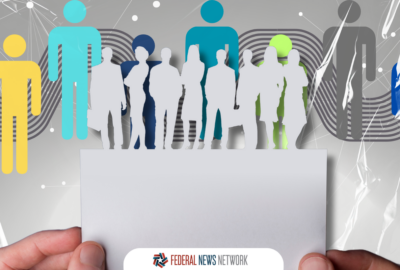Hubbard Radio Washington DC, LLC. All rights reserved. This website is not intended for users located within the European Economic Area.
ASPIRE targets the waste in federal workforce training
Tony Boese, the research programs manager and associate researcher in VA’s NAII, said the new workforce education platform reduces the need for retraining.
Tony Boese likes to tell a story that epitomizes the reason why ASPIRE, an emerging initiative focused on training federal employees, is both a passion project and an opportunity to close long-standing gaps in workforce development.
Boese, the research programs manager and associate researcher in the Department of Veterans Affairs’ National Artificial Intelligence Institute, highlights the training saga of one person who had to take basically the same statistics course six different times.

“She had to take it twice in college as an undergraduate or graduate. Then, she also had to take it when she joined the Navy. Again, when she became a naval aviator. And again when she shifted jobs again to the Naval Postgraduate School. There’s no reason she should have ever needed to do that,” Boese said in an interview with Federal News Network. “There’s no real good system for [carrying forward your previous education] currently. You lose a lot of fidelity about what your training and experience was if you move agency-to-agency, particularly if you’re crossing the Defense Department to civilian duty line, and that leads people to have to waste their time and waste government time and dollars to be retrained.”
The wasting of time and effort is particularly frustrating when agencies are struggling to find and hire qualified employees in everything from cybersecurity to doctors and nurses to accountants. And then add to that the fact that currently, about 8.6% of the federal workforce is under age 30, according to the latest data from the Office of Personnel Management and the Office of Management and Budget. At the same time, more than 28% of the federal workforce is over age 55 — with the average age of a federal employee being 47 years old. The continuous need to hire, train and keep employees equipped for the future, the lack of standardization around training and education is detrimental to the government.
This is where ASPIRE, which stands for All Services Personal and Institutional Readiness Engine, can come in. This innovative approach to training and education can accomplish two major goals for agencies.
First, it can find potential employees who have an aptitude for data science or program management without focusing on degrees or certifications.
Second, ASPIRE can help agencies focus on ensuring their employees have the skill sets they need today and gives them a roadmap for the future.
“The general idea is a system that will help us identify gaps in current knowledge and readiness of employees and/or assess would be employees for their knowledge, given the specifics of their rate, role and agency,” Boese said. “Then once we understand what any gaps might be in the system, which is done through a computer adaptive assessment, then the gap analysis is done. Both of those use artificial intelligence (AI), and then it automatically populates an individualized learning pathway, which also uses AI, to help give that person remediation, or after remediation, it also supports people getting ready for the next position or just exploring curiosities.”

But what ASPIRE does, maybe more importantly, Boese said is try to deliver a good system for government to make sure that agencies don’t have any workforce skillset shortfalls, that employees are empowered for today and the future, and agencies can get the most out of every dollar in their training budget.
“The way we envision the system working in the primary functional process is as you take a computer adaptive assessment, that assessment is absolutely blind to you. All it knows is that you can successfully interact with the computer. So how that works is every question is generated based off your performance and past questions. It starts you in a middle level question and if you do well, the difficulty ramps up, and if you do poorly, the difficulty goes down. Most people will get 20 to 30 minutes of testing,” Boese said. “We don’t want to waste the time with people who don’t need to be tested, and we don’t want to make people who can’t pass the test suffer. It figures out, well, if you’re supposed to know A-B-C-D-E for your role based on the testing, and you know A-B-C, then it’s going to populate something that might have a little splash of those things just to keep fluid the educational experience, but it will mostly focus on D and E. You’ll get your lessons that may be focused on micro and Nano learning.”
He said the goal is to fill the gap or gaps in training as efficiently as possible, maybe in a few hours of “classroom” work versus 10, 20 or even 100s of hours.
The goal is to get the most out of every dollar spent on training, both in real terms or in time spent.
“Every hour of training multiplied across tens to hundreds of thousands, if not millions, of workers in the federal government multiplied by their salaries is a ton of money, and a ton of time off mission,” Boese said.
Carrying forward your knowledge
When NAII and its interagency partners more fully roll out ASPIRE, the goal is for each employee to receive an individualized learning plan, and have multiple ways to learn such as reading text, watching videos or even through AI-generated avatars.
“We do a test again to make sure you actually learned what you learned. I don’t think that anybody in the workforce is dishonest, but self-certification is not a standard on which we should rest our hats,” he said. “Then there’s badging and certification to help you carry forward and show others, ‘hey, look, I did this thing, I earned this thing.’”
That ability of an employee to carry what they learned forward to a new job or new agency is another key aspect of ASPIRE.
As Boese demonstrated with the example of the woman who took statistics six times in her career, having a mutually agreed upon system, set of learning standards and way to demonstrate competency would save time, money and frustrations.
“If we have a system like ASPIRE, where we are all tested in the same way, to the same level of rigor, taught on a mutually agreed upon body of information in a way that is agreed upon, in a system that we know is secure, and that has not been tampered with, and then we can have an output that says what you do or do not know,” he said. “That allows, for instance, somebody coming from DoD to VA, which is lots of people every year, you have a very high fidelity to say, ‘hey up, the Air Force wanted you to know, A through M, and the VA really only cares about A through G, but we’ve also got, you know, S, N and R down the line that we need you to learn. We can just say, ‘hey, look, all I need to do is spin up an S, N and R and then you’re ready to rock. And the VA can understand what you learned, which is a problem that maybe a lot of listeners might not know or think about.”
NAII is working with several agencies, including the Navy’s Naval Postgraduate School, the Air Force Research Lab, the Air Force Institute of Technology, NASA, the departments of Labor and Health and Human Services and several others to develop ASPIRE.
Moving out of beta stage
It’s currently in an alpha/beta mode with a few thousand users testing out the tools and approaches.
Boese said he envisions ASPIRE expanding this year to have tens or hundreds of thousands of users next fiscal year.
“We are starting with data science and AI because the National Artificial Intelligence Institute is the principal sponsor. Also, the original impetus for what put us on this road toward the system was the realization that medical practitioners and researchers were starting to use AI and that we had hired them because they were good doctors, not necessarily because they were good AI persons, and that obviously cropped out from there,” he said. “The Navy and Air Force were early joiners also wanted AI, data science and cybersecurity, while other parts of the Air Force are looking at a lot of electronic warfare and things like that. But the idea is that the system can and will teach certainly hard skills, coding, math and other stuff. But we’re also looking at research into soft skills to try to support potential partners like the Treasury Executive Institute, which is concerned about leadership, or leadership VA which is concerned about leadership management.”
Boese said ASPIRE is open to any agency or any federal employee who’s interested in participating. He said NAII also is looking for help to continue to develop the platform, whether money, people or other kinds of help.
“I think the big benefit is we don’t all need to maintain our own system. We don’t need to have separate licenses or even a shared license. It’s ours. We built it. We own it. The costs can be defrayed and can get very, very low over time because of that,” he said. “The fact also that the government owns it adds a great amount of security. We don’t have private sector or a third party that gets information about our workforce. It’s not just that we’re super secretive, but you could imagine if a third party system is getting continuous queries to teach certain things to certain people, it would not be very difficult for an adversary to reverse engineer where some gaps in readiness or function are or to deduce what we’re going to do next or to figure out a mission area. So it’s much better to have it government-owned inside the mote so that all the information is very tight and secure.”
Nearly Useless Factoid
In 2023, California had the highest number of enrolled college students in the United States.
Source: Yahoo Finance
Copyright © 2024 Federal News Network. All rights reserved. This website is not intended for users located within the European Economic Area.
Jason Miller
Jason Miller is executive editor of Federal News Network and directs news coverage on the people, policy and programs of the federal government.
Follow @jmillerWFED





